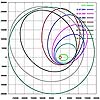 |
Paris, France (ESA) Nov 05, 2004 More than thirty years after the last Apollo mission to the Moon in 1972, there is still much that is unknown about earth's nearest satellite. Now with the aid of ESA's SMART-1, planetary scientists hope to gain new insights into how the moon was it created, and what role it played in the formation of Earth and the advent of life itself on Earth. SMART-1 is due to be captured into lunar orbit on 15th/16th November, and will make the first comprehensive inventory of key chemical elements in the lunar surface. It will also investigate the theory that the Moon was formed following the violent collision of a smaller planet with Earth, four and a half thousand million years ago. The main purpose of the SMART-1 mission is to flight-test the new solar-electric propulsion technology - a kind of solar-powered thruster that is ten times more efficient than the usual chemical systems employed when travelling in space. If all goes well, such a system could be providing the propulsion system for future ESA missions into deep space, such as BepiColombo. However, in the process, the mission will be providing some fascinating science. For example, SMART-1 will be mapping the lunar surface chemical composition more accurately than ever before. Apollo spacecraft carried hand-held cameras to photograph the lunar surface. SMART-1 will be leading the way in the latest imaging techniques. Images taken from many different angles and X-ray and infrared detection work will allow scientists to draw up new three-dimensional models of the Moon's surface. SMART-1 will be looking at the darker parts of the Moon's south pole for the first time. It will be mapping the so-called Peak of Eternal Light, an eerie mountaintop that is permanently bathed in sunlight, while all around are dark craters never touched by the Sun. These craters are believed to harbour water-ice in the lunar soil. SMART-1 will also help scientists to confirm if ice is present at the lunar poles, where the temperature never rises above -170�C. Any water on the lunar surface would be very helpful in the creation of permanent bases on the Moon. SMART-1 was launched from Kourou, French Guiana, on 27 September 2003. After launch, SMART-1 uses its ion drive to spiral out from the Earth until the Moon's gravity catches it and pulls it towards the Moon. The final operational orbit is a polar elliptical orbit, ranging from 300 to 10 000 kilometers above the Moon's surface. On 27 September 2004, SMART-1 celebrated its first birthday in space. After travelling about 78 million kilometers, the spacecraft is in good health with all subsystems functioning as expected. On 25 October 2004, ESA's SMART-1 fired its solar-electric propulsion system, or 'ion engine', for the last time on its way to the Moon. Among important milestones in moon exploration over the last decade, the successful HITEN (formerly called MUSES-A) Japanese mission was launched in 1990, to perform a sophisticated Earth-Moon circumnavigation, including Earth atmospheric breaking. HITEN was finally directed to impact on 10 April 1993 near Stevinus crater on the southeast part of the lunar side. This hyper-velocity planetary impact could be observed from Earth. Between February and May 1994, the American Clementine orbiter observed the Moon with visible, and infrared imagers and a laser ranger which mapped practically the entire lunar surface with a 200 m resolution. Its most remarkable discovery was the strong mineralogical and tectonic large-scale inhomogeneity of the Moon. This explains why, even with the Apollo and Luna samples taken from near-side equatorial areas, we do not know the global Moon. Clementine also discovered the South Pole Aitken basin on the far side, the largest impact basin (2500 km) in the Solar System. Clementine confirmed earlier evidence of permanently shadowed polar craters. A bistatic radar experiment looked at the possible presence of ice in certain polar craters. Clementine's first objective had been to demonstrate new technologies for the United States Strategic Defense Initiative Organisation but lunar and planetary science benefited greatly. Lunar Prospector followed, launched in January 1998. The low-cost NASA Discovery mission had been designed to provide answers to long-standing questions about the Moon, its resources, structure and origins. Lunar Prospector's 18-month mission reaped very valuable scientific data, mapping thorium and potassium radioactive elements and iron. In March 1998 the Lunar Prospector team confirmed the existence of surface hydrogen, with an enhancement at the lunar poles interpreted as water ice. The spacecraft was then deliberately crashed into the Moon's South Pole, in the hope, a vain one, that this water projected into space would be observed and analyzed from Earth. Email This Article
Related Links  Paris, France (ESA) Oct 28, 2004
Paris, France (ESA) Oct 28, 2004On 25 October SMART-1 fired, for the last time, the electric propulsion engine. This small correction manoeuvre of about 4 hours was necessary to correct the slight over-performance of the engine during the last long burn of 100 hours (10-14 October) during the 'third resonance". |
|
| The content herein, unless otherwise known to be public domain, are Copyright 1995-2006 - SpaceDaily.AFP and UPI Wire Stories are copyright Agence France-Presse and United Press International. ESA PortalReports are copyright European Space Agency. All NASA sourced material is public domain. Additionalcopyrights may apply in whole or part to other bona fide parties. Advertising does not imply endorsement,agreement or approval of any opinions, statements or information provided by SpaceDaily on any Web page published or hosted by SpaceDaily. Privacy Statement |